
Sculpture is the branch of the visual arts that operates in three dimensions. Sculpture is the three-dimensional art work which is physically presented in the dimensions of height, width and depth. It is one of the plastic arts. Durable sculptural processes originally used carving and modelling, in stone, metal, ceramics, wood and other materials but, since Modernism, there has been an almost complete freedom of materials and process. A wide variety of materials may be worked by removal such as carving, assembled by welding or modelling, or moulded or cast.

Bertel Thorvaldsen was a Danish and Icelandic sculptor and medalist of international fame, who spent most of his life (1797–1838) in Italy. Thorvaldsen was born in Copenhagen into a working-class Danish/Icelandic family, and was accepted to the Royal Danish Academy of Art at the age of eleven. Working part-time with his father, who was a wood carver, Thorvaldsen won many honors and medals at the academy. He was awarded a stipend to travel to Rome and continue his education.
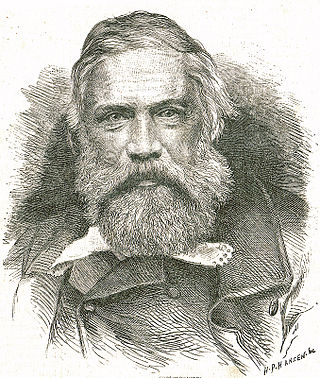
Carl Christian Constantin Hansen (Constantin Hansen) (3 November 1804 – 29 March 1880) was one of the painters associated with the Golden Age of Danish Painting. He was deeply interested in literature and mythology, and inspired by art historian Niels Laurits Høyen, he tried to recreate a national historical painting based on Norse mythology. He painted also many altarpieces and portraits, including the monumental oil painting The Danish Constituent Assembly (Den grundlovgivende Rigsforsamling) between 1861 and 1865.
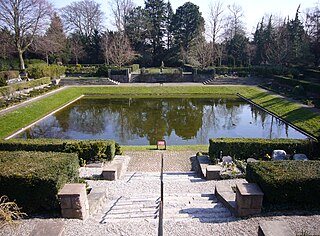
Vestre Cemetery is located in a large park setting in the Kongens Enghave district of Copenhagen, Denmark. With its 54 hectares it is the largest cemetery in Denmark.

The Danish Golden Age covers a period of exceptional creative production in Denmark, especially during the first half of the 19th century. Although Copenhagen had suffered from fires, bombardment and national bankruptcy, the arts took on a new period of creativity catalysed by Romanticism from Germany. The period is probably most commonly associated with the Golden Age of Danish Painting from 1800 to around 1850 which encompasses the work of Christoffer Wilhelm Eckersberg and his students, including Wilhelm Bendz, Christen Købke, Martinus Rørbye, Constantin Hansen and Wilhelm Marstrand, as well as the sculpture of Bertel Thorvaldsen.

Christian Albrecht Jensen was a Danish portrait painter who was active during the Golden Age of Danish Painting in the first half of the 19th century. Painting more than 400 portraits over the course of his career, he depicted most of the leading figures of the Danish Golden Age, including the writer Hans Christian Andersen, the painter Christoffer Wilhelm Eckersberg, the sculptor Bertel Thorvaldsen, the physicist Hans Christian Ørsted and the theologian N. F. S. Grundtvig.
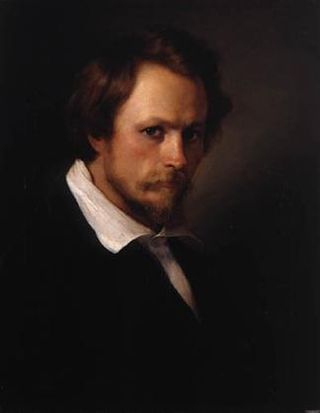
Emil Jens Baumann Adolf Jerichau was a Danish sculptor. He belonged to the generation immediately after Bertel Thorvaldsen, for whom he worked briefly in Rome, but gradually moved away from the static Neoclassicism he inherited from him and towards a more dynamic and realistic style. He was a professor at the Royal Danish Academy of Fine Arts and its director from 1857 to 1863.

Aksel (Axel) Einar (Ejnar) Utzon-Frank was a Danish sculptor and professor at the Royal Danish Academy of Fine Arts. During his lifetime, he produced many sculptures, some of which stand as public monuments. Utzon-Frank was son of Jens Christian Frank and Anna Cathrine Utzon. Anna Cathrine was sister to the grandfather of Pritzker Prize-winning architect Jørn Utzon.

Danish art is the visual arts produced in Denmark or by Danish artists. It goes back thousands of years with significant artifacts from the 2nd millennium BC, such as the Trundholm sun chariot. For many early periods, it is usually considered as part of the wider Nordic art of Scandinavia. Art from what is today Denmark forms part of the art of the Nordic Bronze Age, and then Norse and Viking art. Danish medieval painting is almost entirely known from church frescos such as those from the 16th-century artist known as the Elmelunde Master.

Christian Gottlieb Vilhelm Bissen was a Danish sculptor. He was also a professor at the Royal Danish Academy of Fine Arts with great influence on the next generation of Danish sculptors and for a while served as its director. Bissen was trained in the Neoclassical tradition from Bertel Thorvaldsen but after a stay in Paris around 1880, he was influenced by Naturalism. With the equestrian statue of Absalon he turned to Neo-romanticism.
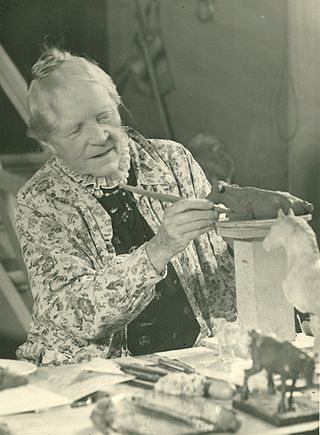
Anne Marie Carl-Nielsen was a Danish sculptor. Her preferred themes were domestic animals and people, with an intense, naturalistic portrayal of movements and sentiments. She also depicted themes from Nordic mythology. She was "one of the first women to be taken seriously as a sculptor," a trend-setter in Danish art for most of her life. She was married to the Danish composer Carl Nielsen.

August Vilhelm Saabye, also known as August Wilhelm Saabye, was a Danish sculptor.
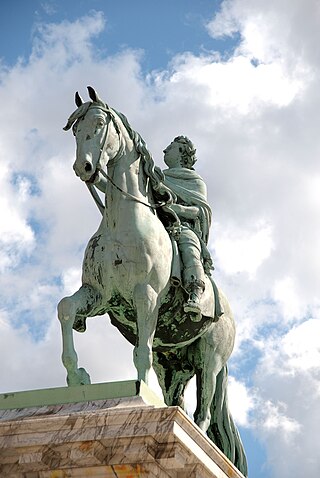
Danish sculpture as a nationally recognized art form can be traced back to 1752 when Jacques Saly was commissioned to execute a statue of King Frederick V of Denmark on horseback. While Bertel Thorvaldsen was undoubtedly the country's most prominent contributor, many other players have produced fine work, especially in the areas of Neoclassicism, Realism, and in Historicism, the latter resulting from growing consciousness of a national identity. More recently, Danish sculpture has been inspired by European trends, especially those from Paris, including Surrealism and Modernism.
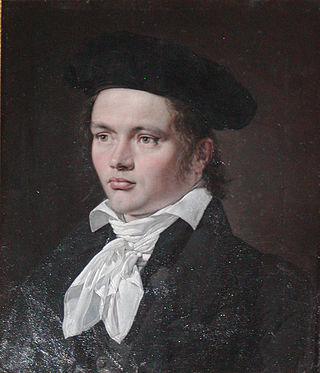
Hermann Ernst Freund was a German-born Danish sculptor. He is remembered in particular for his figures from Nordic mythology and for the Ragnarok Frieze.

Rasmus Morten Andersen was a Danish sculptor. He is mainly known for his naturalistic portraits.
Søren Georg Jensen was a Danish silversmith and sculptor. Son of the noted silversmith Georg Jensen, he was the artistic director of the Georg Jensen Silversmithy from 1962 to 1974.
Sven Dalsgaard Jensen was a Danish painter, sculptor and writer.

The statue of Frederick VI greets visitors just inside the main entrance to Frederiksberg Park at Frederiksberg Runddel in the Frederiksberg district of Copenhagen, Denmark. The bronze statue was created by Herman Wilhelm Bissen and is considered one of his best works. It was unveiled on 10 September 1858.